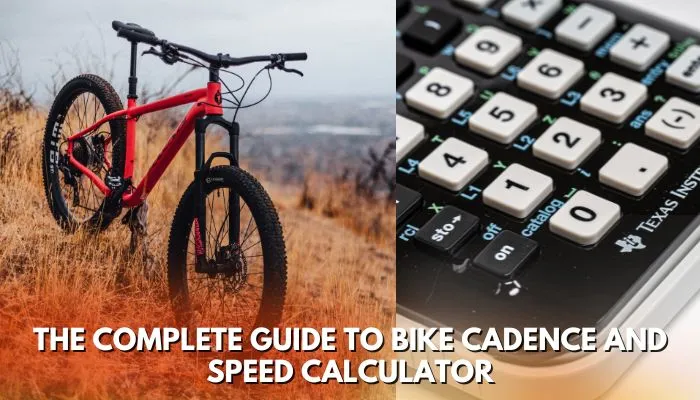Bike Cadence And Speed Calculator | How To Use

A bike cadence and speed calculator can be useful for bikers who want to track their performance and improve their training. Cadence refers to the rate at which a biker rides, usually measured in revolutions per minute (RPM), while speed refers to how fast the bike is moving. By keeping track of both cadence and speed, bikers can get a better understanding of their performance and make adjustments to their training accordingly.
Some bike computers and GPS devices have built-in cadence and speed sensors that automatically calculate your cadence and speed. There are also smartphone apps and websites that can help you calculate your bike cadence and speed based on data collected from sensors on your bike or from your phone’s GPS.
Table of Contents
The Bike Cadence And Speed Calculator:
Bike Cadence and Speed Calculator
Gear Ratio:
This calculator for biking cadence and speed may assist you in estimating your cadence when you know your speed, or it can work the other way around it and estimate your speed when you know your cadence.
You may select your chainring, gear, wheel size, tire size, pace, and cadence, which will provide the rest of the details. Whether you’re searching for a cadence calculator or a bike speed calculator, our flexible tool is a wonderful option.
A bike cadence and speed calculator helps you determine the speed and cadence at which you are cycling. Cadence is the number of pedal revolutions per minute (RPM), while speed is the rate at which you are traveling in miles per hour (mph) or kilometers per hour (km/h).
To use a bike cadence and speed calculator, you typically need to input certain parameters such as the gear ratio, wheel size, and your average cadence. The calculator then uses these inputs to compute your speed in mph or km/h based on the distance traveled per pedal revolution and your cadence.
Significance Of Cadence And Speed Calculator:
A bike cadence and speed calculator typically requires you to input certain parameters, such as your gear ratio, wheel size, and cadence. It then uses these inputs to estimate your speed and other related metrics, such as your power output and distance traveled. This information can be helpful for bikers who want to track their performance and optimize their training routines.
Cadence refers to the number of revolutions your pedals make per minute (RPM). It is an important factor to consider when biking, as it can affect your power output and overall efficiency. A higher cadence generally means that you are pedaling faster, which can help reduce strain on your muscles and improve endurance.
Speed, on the other hand, refers to how fast you are traveling on your bike. This is affected by various factors, including your gear ratio, the slope of the terrain, wind resistance, and your own physical abilities.
How To Use This Calculator
Do the following action to utilize the bike gearing ratios analyzer. After selecting your chosen cadence and tire size, enter the total number of teeth on your chainrings as well as the cassette. Next, select the size of your bicycle’s wheel and chainrings. To get your results, press the calculate button.
Here is a little explanation that can be beneficial if you’re uncertain about what to input:
- The diameter of the wheel is known as the rim size. By glancing at the sidewall of your tires, you may estimate this measurement.
- The tire size defines your tire’ width in millimeters. You may also find this number on the sidewall of the tires.
- Your bike’s cadence, or speed, is governed by the number of rotations you make per minute. Although the majority of bikers ride between 80 and 95 RPM, you need to have a cadence meter to determine your normal cadence.
- On your bike’s front sprockets, next to the crank arms, are termed the “chainrings,” which are the count of teeth. The most typical sizes for road bikes include an outside tooth count of 50, 52, or 53 and an inner tooth count of 36 or 34. Thus, for instance, enter “52, 36” into the calculator when you have 52 & 36 chainrings.
- Your bike’s back sprockets have a certain number of teeth, known as a cassette. 11-28, 11-30, 11-34, and so forth are a few examples of cassette sizes. Depending on the manufacturer of your groupset, there are frequently 10 to 12 sprockets on the cassette.
Why Would You Use This Calculator?
In biking, it’s essential that you keep the appropriate cadence. You will experience muscle exhaustion more rapidly and run a higher likelihood of getting knee pain if you ride too slowly. On the opposing side, biking too rapidly may strain your aerobic endurance and elevate your pulse rate.
The optimal cadence for the majority of bikers is between 80 and 95 RPM, while every rider has a slightly different cadence.
This calculator may be used to calculate the gearing, which will enable you to keep your preferred cadence. Simply experiment with different cassette configurations in order to determine if you can find the optimum condition for your particular cadence.
You may also use the calculator to determine how swiftly or slowly you can move with your existing configuration. This is beneficial for both uphill and downhill traveling.
When climbing a hill, you would rather not run out of cassettes and have to ride very gradually, which is hazardous for your knees. In a comparable manner, when going downhill, you should prevent spinning too rapidly.
Benefits Of Using A Bike Cadence And Speed Calculator:
A bike cadence and speed calculator is a tool that allows you to estimate your speed and cadence while biking, based on certain input parameters. Here are some of the benefits of a bike cadence and speed calculator:
- It helps bikers optimize their pedaling efficiency:
By tracking their cadence, bikers can ensure that they are pedaling at an optimal rate for their fitness level and the terrain they are riding on. A high cadence can help reduce stress on the knees and improve endurance, while a lower cadence can help build strength.
- It helps bikers track their progress:
Tracking their speed and cadence over time allows bikers to monitor their progress and set goals for improvement. They can also identify areas where they need to focus their training and adjust their workouts accordingly.
- It helps bikers plan their rides:
By knowing their average speed and cadence, bikers can plan their rides more effectively and estimate how long it will take them to cover a certain distance. This can help them plan their routes and schedule their rides more efficiently.
- It helps bikers compare their performance with others:
By using a bike cadence and speed calculator, bikers can compare their performance with other riders and see how they stack up. This can be motivating and help them push themselves to improve.
Overall, a bike cadence and speed calculator can be a valuable tool for bikers who want to improve their performance, track their progress, and get the most out of their training.
Risks of using cadence and speed calculator:
Using a bike cadence and speed calculator can have some risks if the results are not interpreted and used properly.
- One risk is relying too heavily on the calculator’s output and not paying attention to your own body’s signals. For example, suppose the calculator suggests a certain cadence or speed, but you feel uncomfortable or exhausted trying to maintain that pace. In that case, it’s important to listen to your body and adjust accordingly.
- Another risk is using inaccurate or unreliable data in the calculator, which can lead to incorrect results. This can happen if the input data is not precise or if the calculator is not calibrated correctly. It’s important to use reliable data sources and to double-check the calculator’s output to ensure accuracy.
- Additionally, some calculators may not take into account external factors such as wind resistance, terrain, or changes in elevation, which can affect your actual speed and cadence. It’s important to use the calculator as a rough guideline and to adjust for these external factors as needed.
Overall, using a bike cadence and speed calculator can be a useful tool for tracking your progress and setting goals. Still, it’s important to use it in conjunction with your own instincts and to verify the accuracy of the data and results.
FAQs
How can I figure out my cadence?
Just counting the number of times your legs rise and fall in a minute is the most straightforward approach to estimating your cadence. But, you may utilize electrical equipment (cadence monitors) to write things down more accurately. A lot of bike cadence sensors are made to be connected to the left-side chainstay.
What is the bike’s simplest speed?
Since that there is only one gear shifting system and only one chainring in a 7-speed, it is less complicated to use (21-speeds have two, single for the front and single for the rear gears). Moreover, it is lighter. You will have a reduced range of gears to pick from if you choose a bike with a 7-speed setup.
Can you ride more quickly with a greater cadence?
The common misconception among recreational bikers is that riding more quickly will truly speed them. Yet according to research, amateur bikers who bike at a high cadence do so incompetently and risk getting exhausted.
Conclusion:
This bike cadence and speed calculator for biking cadence and speed may assist you in calculating your cadence when you know your speed, or it can switch modes around and predict your speed when you know about cadence. You may select your chainring, gear, wheel size, tire size, velocity, or cadence, and it will provide the rest of the details. Whether you’re searching for a cadence calculator or even a bike speed calculator, our comprehensive gadget is a wonderful option.

Thank you for highlighting the importance of using a bike suspension calculator. You’ve articulated it perfectly! Customizing your suspension setup to match your personal preferences and needs can make a world of difference in your riding experience. It’s all about finding that sweet spot for traction, control, and handling, whether you’re tackling rough terrain or pushing the speed limits.
If you have any specific questions or need advice on using a suspension calculator effectively, please feel free to ask. I’m here to help with any further information or tips you might need.
Happy riding! ?♂️?♀️
lockout system so you can use it while riding off-road. On rough or bumpy terrains, assistance from suspension is excellent, but why will you need it on smooth and flat roads where you can cycle quickly? So